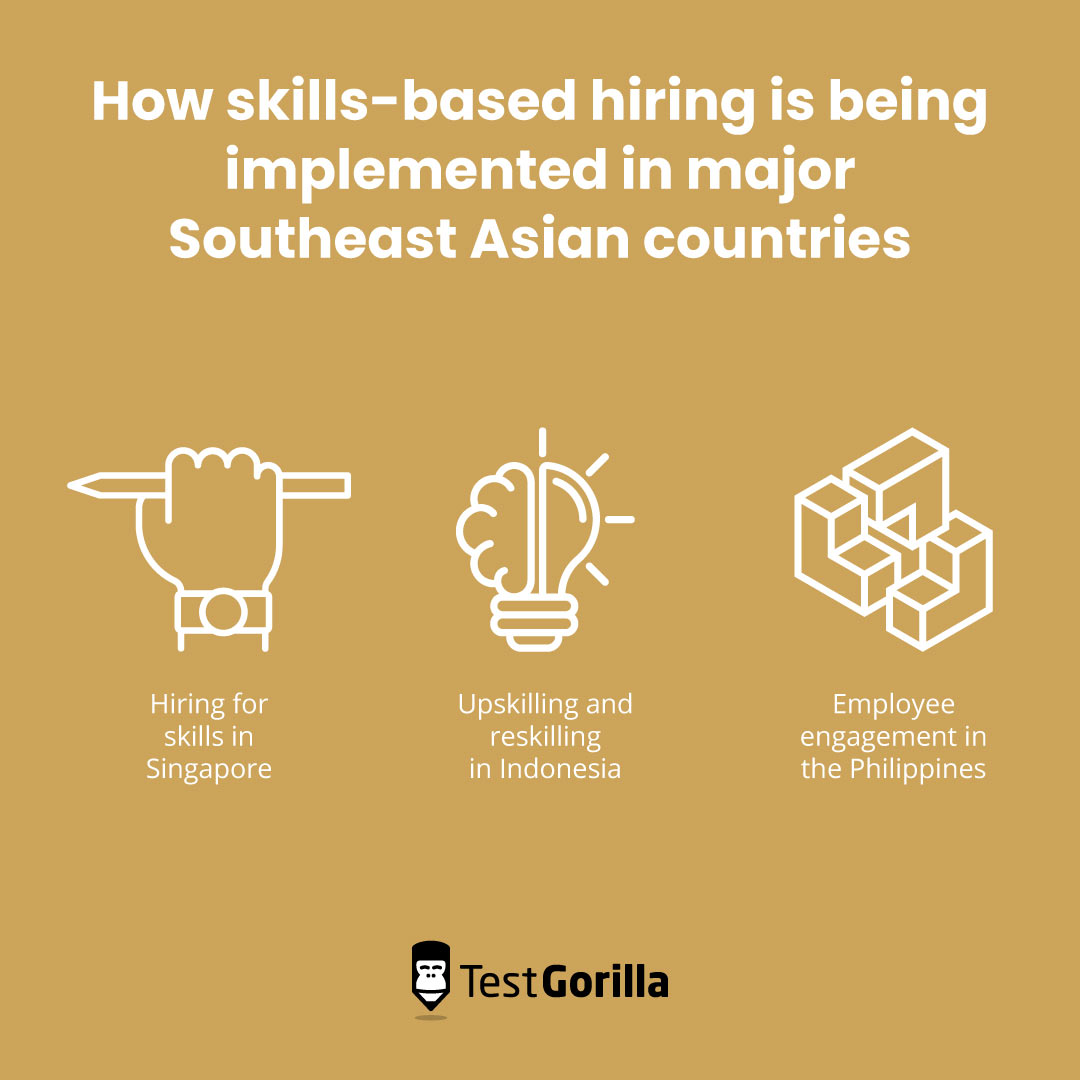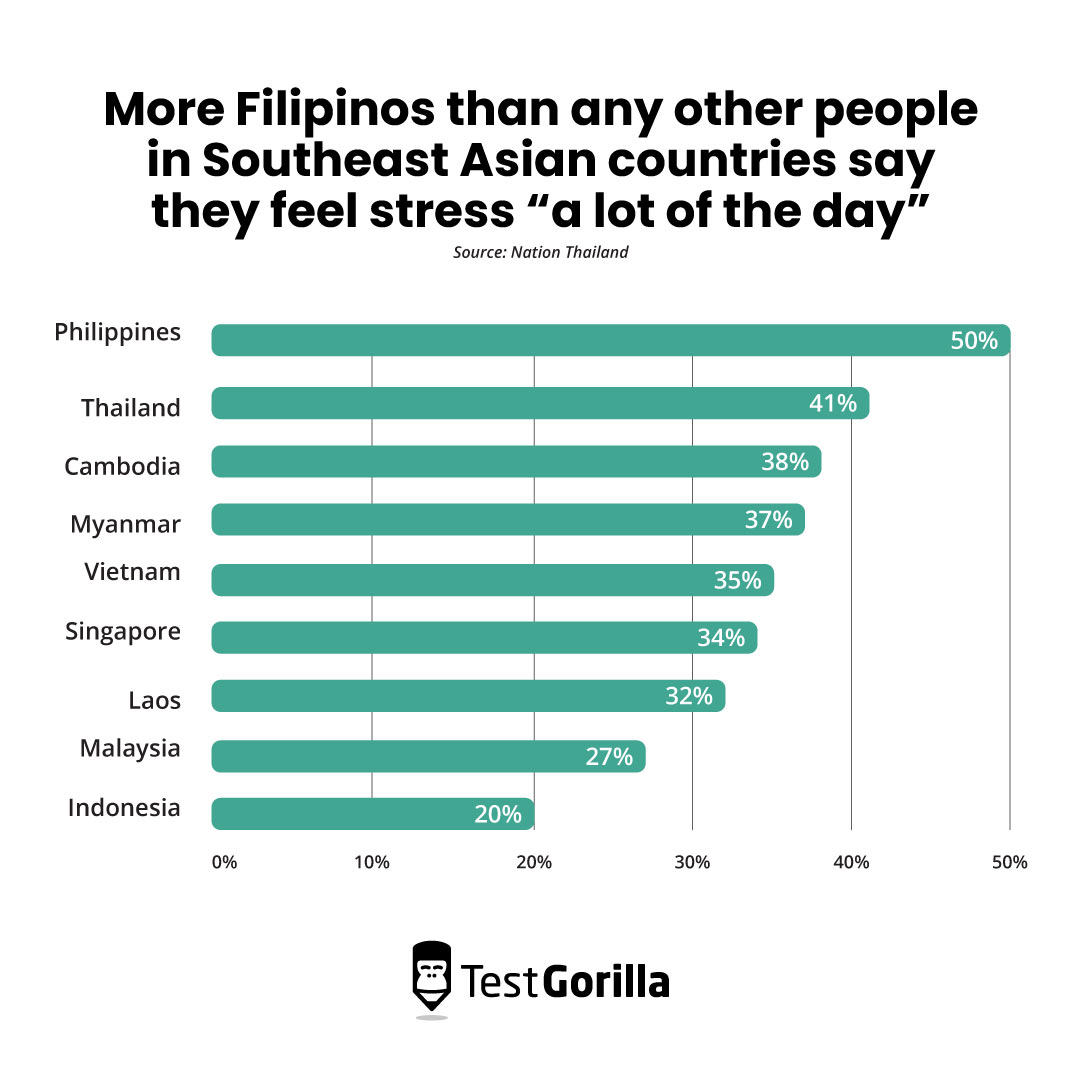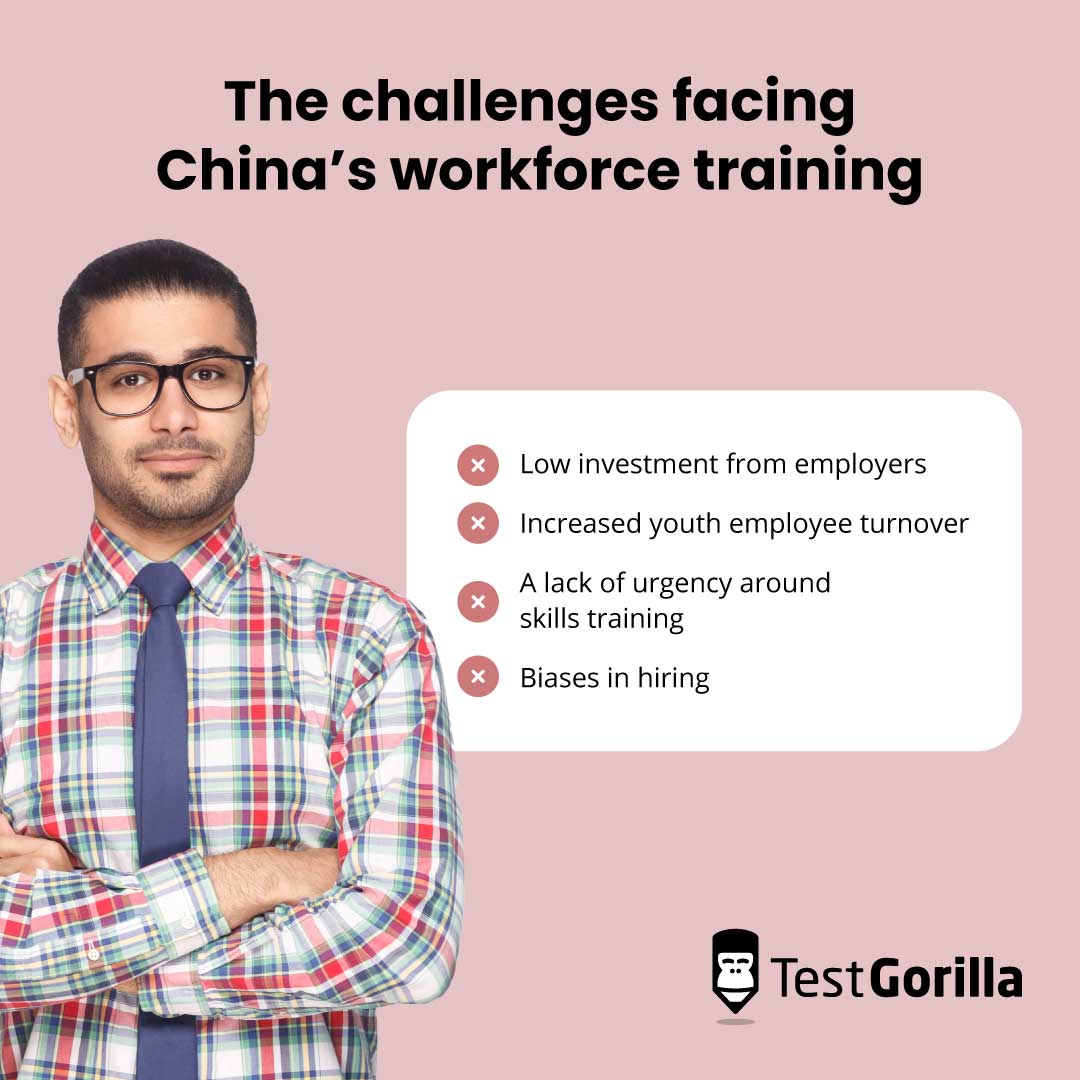Is skills-based hiring the latest APAC hiring trend?
The global skills shortage is ongoing.
Many skilled workers are being turned away by employers because of a lack of formal education or experience on their resumes.
Many employers are not offering workers learning and development opportunities even though 45% of workers say they would stay at their company longer if it invested in their growth.[1]
Skills-based hiring is a proven strategy to locate, retain, and develop skilled workers. In fact, The State of Skills-Based Hiring 2024 found that 81% of employers globally are using skills-based hiring to identify talent.
But do Asian-Pacific (APAC) countries, where the bulk of the world’s working population lives, fit into this?
This article dives into the current skills-based hiring situation in prominent APAC countries to explore how companies are adapting, the role that governments play, and the cultural and social factors that are driving (or preventing) the benefits of skills-based hiring.
Finally, we’ll take a look at how skills-based hiring can fill the gaps that the majority of APAC economies are experiencing and the lessons the rest of the world can learn.
“APAC” can be an ambiguous term, so in this article, we’ll use it to refer to East and Southeast Asian countries as well as Oceania.
Table of contents
Skills-based hiring is on the rise in Southeast Asia
In general, Southeast Asian work culture strongly emphasizes hierarchy, conflict resolution, work-life balance, and continuous learning and improvement.[2]
In many Southeast Asian countries, education is viewed as the pathway to success, and it’s common for Southeast Asian professionals to pursue ongoing education and training opportunities throughout their careers.
But research also shows that a high percentage of Southeast Asian students lack basic competencies, which is detrimental to future skills development.
For example, more than 50% of students in Indonesia and the Philippines are classified as low achievers who struggle with literacy, numeracy, critical thinking, and associative reasoning.
Although many Southeast Asian businesses place a strong emphasis on skills, this may be in response to an education system that leaves its students underprepared to succeed in professional life.
This is why it’s not surprising that skills-based hiring has taken a firm hold in the region.
Research from the OECD shows that many Southeast Asian organizations have put these beliefs into practice with robust training and development programs sponsored by governments and private businesses alike.
That being said, the region is not immune to talent shortages.
According to a 2023 LinkedIn report, 55% of recruiters in Southeast Asia believe that finding candidates with the right skills is a serious challenge.[3]
How is Southeast Asia responding? An impressive 89% of recruiters in the region are prioritizing skills-based hiring, and 87% are prioritizing upskilling and reskilling.
Let’s take a closer look at how skills-based hiring is being implemented in major Southeast Asian countries.
Hiring for skills in Singapore
Singapore is one of the most advanced and stable economies in the world. However, it’s not immune to the fallout of the Covid-19 pandemic that closed borders and threatened prominent sectors of their economy, like tourism and tech.
84% of employers reported difficulty filling roles in 2022, which was a 20% increase from 2021.
Singaporean officials are well aware of these obstacles and the high-stakes global talent war.
As a small island nation, Singapore doesn’t have much in the way of natural resources. According to its Minister of Manpower, Tan See Leng, Singapore’s primary resource is talent, making talent acquisition a key strategy for the country.
So, how are the government and businesses doing with skills-based hiring? Are they following the lead of the US, where the majority of the labor force is skilled through alternative routes, like STARs?
In short, Singapore is having some success, like many other APAC countries that are adopting skills-based hiring practices.
According to NTUC LearningHub’s Emerging Jobs and Skills report, as of 2021, 79% of employers are looking to hire talent with a broader set of skills for hybrid roles in the fields of data science, marketing, and sales.
Hiring for skills is a main concern for Singaporean employers, but it’s not the only one. Almost half of the respondents said that upskilling and reskilling employees is a key strategy moving forward.
How is the Singaporean government responding to this concern?
Singapore’s SkillsFuture program is a government initiative to support the career transition of Singaporean workers across different industries like manufacturing, hospitality, and healthcare.
With 26% of Singaporean job seekers wanting to change careers or industries, SkillsFuture’s three to six-month part-time training program identifies and develops workers’ transferable skills to help them pivot to industries that are hiring for skills over degrees.
But is the initiative successful?
According to workforce advisory leader Samer Bedi, the initiative has been successful but could go further by helping each individual worker measure their existing skills and identify areas to improve.
While having transferable skills is an advantage to both employees and employers in venturing into new industries, job seekers need to be open to accepting lower-salaried positions to build experience and improve skills.
In 2023, Singapore is projected to have a strong hiring market, with eight of nine sectors expecting staffing levels to increase this year. The information technology sector, however, is still experiencing talent shortages: 84% of organizations are finding it difficult to secure the talent they need.[4]
Upskilling and reskilling in Indonesia
Due to its large population – nearly that of the US – Indonesia is the largest economy in Southeast Asia.
Despite this, its current labor deficit puts the country on track to suffer losses in economic growth by 19%, the equivalent of nearly $443bn.[5]
This labor deficit is closely tied to a digital skills gap, which the retail and hospitality sectors are suffering from the most.
So, how is Indonesia taking steps to address this skills gap?
Historically, upskilling and reskilling opportunities have been rare in Indonesia. Research from 2019 shows that 90% of Indonesia’s workforce has never attended any formal training programs due to limited access to resources like information and financial support.[6]
Where such programs do exist, many workers are not given adequate time and flexibility to complete them.
The Indonesian government has long attempted to offer vocational training programs to upskill and reskill the workforce, but many of these programs were localized and occurred offline, which made them difficult to scale.
In 2020, however, the Indonesian government placed a heightened emphasis on skills training.
The Kartu Prakerja, for example, is a career development government program launched during the Covid-19 lockdown that combines self-paced online learning modules with financial and social assistance so unemployed workers can receive skills training to start a career or small business.[7]
Since 2020, the Prakerja program has reached more than 16 million people across Indonesia, increasing the number of workers receiving skills training by nearly 20%.
Sianny, a young man from West Kalimantan, is an excellent example of the program’s success. Sianny used to work at a palm oil plantation, but after taking Prakerja courses, he began a successful career in web development.
Employee engagement in the Philippines
Research shows that more companies in the Philippines prefer to hire candidates with skills over formal education or experience.
Specifically, 38% of employers want to hire candidates with technical skills over traditional qualifiers like education and experience requirements. Only 12% of employers feel that education and experience are more important than skills.[8]
HR leaders in the Philippines are zeroing in on employee engagement as a main factor in attracting and retaining skilled talent.
Employee engagement is the emotional commitment an employee has to their organization and its goals. According to Gallup, a highly engaged workforce generates 21% greater profitability.[9]
Skills-based hiring methods include pre-employment assessments like personality tests and situational tests to evaluate a candidate’s motivation, attitude, and work ethic. Looking beyond technical skills to assess a candidate’s mental and emotional attributes is a great way to locate and retain engaged employees.
Skills-based hiring also builds more inclusive organizations, which increases employee engagement.
Research from Deloitte reveals that 83% of millennial employees are actively engaged at work when they believe their organization fosters an inclusive culture.[10]
This is especially relevant to Filipino businesses because a report from the Philippine LGBT Chamber of Commerce found that only 17% of the 100 businesses surveyed have inclusive policies for employees with diverse gender identities and sexual orientations.[11]
Research from Culture Amp shows that 84% of employees in the Philippines are engaged at work, which is in the top 17% compared to other regions.[12]
So what exactly is boosting employee engagement in the Philippines? The evidence points toward a people-first workplace culture.
According to William Ng, group publisher and editor-in-chief of Business Media International, many Filipino employers provided monetary and emotional support to the millions of Filipinos working during the height of the Covid-19 pandemic.[13]
This people-first approach is a core foundation of skills-based organizations because candidates and current employees are treated as more than just workers. Rather, employers treat their employees as multifaceted human beings.
To be clear, even with many Filipino companies expending time and resources to boost employee wellbeing and engagement, Filipino workers had the highest levels of stress in all of Southeast Asia in 2021.
This is not a contradiction – it’s very common for high engagement to correlate with high stress. Think about it: A worker who cares about their job and is actively engaged with it is more likely to stress about it.
Consider high-stress professions like lawyers, surgeons, or pilots. You wouldn’t say they’re unengaged, would you? For that reason, any company that’s trying to improve employee engagement should simultaneously focus on ways to improve employee wellness as well.
Skills-based hiring is the top recruitment strategy in India
The number of positions without degree requirements increased by almost 40% in India between 2019 and 2020.[14]
Why? More Indian companies are shifting toward skills-based hiring methods like skills assessments. In fact, nearly half of Indian tech recruiters use some form of online assessment tools in their hiring processes.[15]
This trend has not gone unnoticed. 82% of Indian professionals agree that more companies are hiring for skills over degrees and experience.
According to Ashutosh Bupta, LinkedIn India country manager, Indian workers are reevaluating how they approach their careers.[16] New generations of workers are looking at their career paths as nonlinear, and they’re refusing to compromise when it comes to their values and when and how they want to work.
Building healthy workplace cultures in India
Many Indian companies are accepting the demands of their labor forces.
According to Lakshmi C., managing director and lead at Accenture in India, diverse perspectives and inclusive workplace cultures are what multiply innovation and growth.[17]
Meeting this demand for a healthy workplace culture is another tenet of skills-based hiring practices. A healthy workplace is one where employees feel appreciated, fulfilled, and inspired to produce quality work and support their peers.
Lakshmi breaks down her organization’s approach into three key categories that all point to a blooming skills-based hiring process:
Inclusion. Accenture India claims they seek out, encourage, and participate in dialogue with employees across ages, gender identities, sexual orientations, abilities, and ethnicities to create an environment of trust and empowerment.
Employee wellbeing. According to Lakshmi, Accenture India is committed to focusing on their employees’ mental wellbeing by promoting holistic self-care.
Learning and development. Upskilling and reskilling employees are also top priorities. Accenture spends nearly $1bn on learning and development globally each year.
Learning and development are not unique to Accenture India.
India has a vital ed-tech industry that focuses heavily on upskilling courses to jumpstart careers and empower its workforce. Intellipaat, for example, is a prominent Indian ed-tech company that offers specialized courses in Cloud and DevOps. Its Cloud Architect Certificate Program offers skills training in DevOps, Python, Java, and Splunk.
With nearly 88% of Indian employees expecting to continue their learning and development throughout their careers, the Indian tech sector is leading the charge to meet expectations.[18]
It’s not all good news: The gender pay gap is still wide in India
Although the tech industry is making significant strides in skills-based hiring initiatives, the gender pay gap remains severe in India.
Research shows that Indian women, on average, earn almost one-fifth of Indian men’s income.[19]
This gap is felt in organized and unorganized work sectors across urban and rural environments. Indian women are also limited in their ability to negotiate higher wages when compared to their male counterparts. In rural sectors, where remote work offerings are limited, women are often cornered into industries that force them to take unequal pay.
India’s growing skills-based hiring practices are a positive sign for a workforce that seeks fair treatment, learning and development opportunities, and a chance to show their skills in the hiring process.
However, issues like the gender pay gap prove there is still plenty of work to be done to pay all workers fairly for their skills and abilities.
China is slow to adopt skills-based hiring
China has historically placed a strong emphasis on education.
Research shows that students face significant pressure to perform well in school, ace exams, and find jobs with good salaries as a result.[20]
But foreign companies who do business with China and researchers agree that the country’s education system is not producing enough skilled graduates.
As we’ve seen, relying on degrees and education experience as a predictor of job success is a flawed approach. In fact, research proves that a combination of skills assessments and structured interviews are the strongest predictors of job success – not degrees.[21]
China’s skills development problem
So, how is China faring?
According to research from McKinsey, China’s skills development system needs to be transformed to sustain economic growth and improve living standards.[22]
China’s workforce training is facing a number of challenges:
Low investment from employers
Increased youth employee turnover
A lack of urgency around skills training
There are several key areas where skills are missing: critical thinking, decision-making, interpersonal skills, and technical skills.
Skills-based hiring moves away from traditional education requirements to locate talent that has the exact blend of hard and soft skills that many Chinese companies need.
This is because candidates who can prove they’re able to think critically, respond well to role-specific situations, and learn the technical skills to achieve organizational goals are most likely equipped for the role.
According to China’s Ministry of Education, the country will experience a shortage of nearly 30 million workers in the manufacturing sector by 2025.[23]
Although manufacturing jobs in China are paying higher wages, the shortage is being caused in part by long-held perceptions of blue-collar (technically-skilled) jobs as inferior.
According to Zhang Xiarao, director of Silk Road Vocational College, traditional Chinese Confucian culture is an important historical reason for Chinese society’s negative perception of blue-collar work, which has been classified as undignified.
This cultural attitude, combined with high turnover in the manufacturing sector, makes it clear that workers are not being effectively recruited, developed, and retained.
Take the Chinese industrial workforce, for example. Many Chinese industrial workers frequently change roles, companies, and even cities. Government data shows that turnover in this sector continues to rise.[24]
Managing employee turnover is crucial to organizational success because the alternative is a drain on company resources when you factor in the lost productivity, hiring costs, strain on HR staff, and drain on employee morale.
But high turnover also limits employee ability to hone existing skills and learn new ones. Migrant workers especially suffer from a lack of skills investment.
China has been known to target migrant workers by locking them out of public services in the cities they settle in. If workers are stuck in precarious living situations, they often seek flexible forms of employment, which contributes to China’s skills development problem.
Skills-based hiring is most valuable in an environment where workers, at the very least, have access to skills training opportunities. In China, many cultural, political, and historical factors indicate the nation is lagging behind its Asian neighbors and the rest of the world when it comes to skills-based hiring.
How are Australia and New Zealand approaching skills-based hiring?
According to the Tech Council of Australia, the nation is closing in on its target of 1.2 million tech workers by 2023.[25]
With skills-based hiring on the rise globally, Australia has embraced pre-employment testing to screen employees for relevant skills and personality alignment.
The Institute of Psychometric Coaching, for example, is an industry leader in Australia that trains job seekers to feel better prepared to take these types of pre-employment assessments on the job market.
But is Australia and New Zealand's embrace of skills-based hiring strategies, like skills and personality testing, sufficient to adapt to an increasingly skills-based global economy?
Let’s explore how these two nations are approaching talent shortages and hiring for skills.
Australia’s approach to the digital skills gap
Although Australia is embracing skills-based hiring, upgrading Australian hiring practices may not be enough to meet future workforce needs.
According to Rod Farmer, a McKinsey associate partner in Sydney, the rapid transition from a job-based economy to a skills-based economy is revealing significant skills gaps, not only in digital and tech spaces but across all sectors of the Australian labor market.[26]
How has the Australian government responded?
Australia’s Department of Regional New South Wales (DRNSW) supports regional communities through agriculture and infrastructure projects. During the Covid-19 pandemic, this organization was one of many that found its remote-based employees were struggling to show the right amount of digital skills and literacy to adjust.
According to Donna McLeod, acting chief of the agency, they had a large number of employees who were trying to work around technology to accomplish tasks because they didn’t have basic digital skills – like knowing how to join a Zoom meeting.[27]
The agency’s response was to create the Digital Skills Program, which was a completely new reskilling initiative within the department.
Although government-led efforts such as this program are an encouraging sign, Australia’s digital skills gap is still costing Australian businesses $3.1bn annually – a clear reminder that skills-based hiring is more than a simple skills-training exercise.
Rather, it’s a holistic approach that locates existing talent within the workforce, identifies growth potential, and empowers employees to develop their careers with the support of their entire organization.
New Zealand’s approach to skills shortages
New Zealand, like most of its APAC neighbors, is not immune to skills shortages.
In fact, a survey from the Employers and Manufacturers Association of New Zealand shows that 90% of employers in New Zealand admit they are struggling to fill vacancies with skilled talent.[28]
The survey also shows that highly skilled jobs were the hardest to fill, according to 71% of respondents.
With a domestic population that’s lacking desperately-needed numeracy and literacy skills, New Zealand’s leaders have blamed emigration as the main culprit. In other words, skilled workers are leaving New Zealand to work elsewhere.
But recruiting overseas talent has been a challenge due to many employers’ struggles when it comes to navigating the migrant visa process.[29]
How are employers intending to work around this roadblock?
In addition to focusing on immigration and youth engagement, 71% of New Zealand employers say upskilling and reskilling are their main priorities, according to 2023 findings from the Employers and Manufacturers Association.[30]
With upskilling and reskilling opportunities being some of the most attractive for global talent, New Zealand appears to be heading in the right direction. But a focus on upskilling and reskilling for an under-skilled population like New Zealand’s is no walk in the park.
For employers and employees to experience the benefits of skills-based hiring, companies and government agencies need to align on what makes a qualified candidate rather than outlining job responsibilities.
Identifying a skills shortage is an important first step. But the process really begins when employers move away from the traditional understanding of hiring and workplace culture in favor of a philosophy that encourages employees to learn and grow within an organization.
Employers in APAC and beyond are hiring for skills
There’s no doubt that skills-based hiring is on the rise – and it's time to join the skills-based movement.
Organizations and governments across Asia-Pacific are using skills-based hiring practices like pre-employment testing in Singapore, building healthy workplace cultures in India, and investing in learning and development opportunities in Indonesia to attract and retain quality talent for the long term.
There’s a lot to be learned from exploring the different ways these countries hire for skills, but also from other countries that are struggling to fill skills gaps, like China and New Zealand, for example.
Remember: Skills-based hiring is more than just giving candidates skills tests.
It’s a holistic hiring process that evaluates the whole candidate – taking into account their unique social and political context – to find the best talent for your organization and addition to its culture.
To get started with skills-based hiring, book a demo with TestGorilla or try our skills-based hiring platform for free.
Master skills testing with varied test types
Delve into the variety of skills tests we offer. Sign up for our free live demo to see how diverse assessments can enhance your hiring process.
Sources
Flynn, Jack. (March 9, 2023). “35 Key Employee Training and Development Statistics [2023]: Data + Trends”. Zippia. Retrieved June 26, 2023. https://www.zippia.com/employer/employee-training-development-statistics/
“10 Characteristics of Workplace Culture in Southeast Asia You Need to Know”. (April 11, 2023). 9cv9. Retrieved June 26, 2023. https://blog.9cv9.com/10-characteristics-of-workplace-culture-in-southeast-asia-you-need-to-know/
“The Future of Recruiting 2023”. (2023). Linkedin. Retrieved June 26, 2023. https://business.linkedin.com/content/dam/me/business/en-us/talent-solutions/resources/pdfs/future-of-recruiting-2023.pdf
Sofiah, Arina. (March 14, 2023). “Strong hiring outlook anticipated for Singapore in Q2 2023”. Human Resources Online. Retrieved June 26, 2023. https://www.humanresourcesonline.net/strong-hiring-outlook-anticipated-for-singapore-in-q2-2023
“Indonesia to Experience Labour Shortage Across Key Industries by 2023 According to Jobs App KUPU”. (October 11, 2022). Yahoo! Finance. Retrieved June 26, 2023. https://finance.yahoo.com/news/indonesia-experience-labour-shortage-across-082600951.html?
Stanistreet, Paul. (April 24, 2023). “Creating upskilling opportunities for 144 million Indonesians”. UIL. Retrieved June 26, 2023. https://thelifelonglearningblog.uil.unesco.org/2023/04/24/creating-upskilling-opportunities-for-144-million-indonesians/
“Program Kartu Prakerja”. (2022). United Nations Department of Economic and Social Affairs. Retrieved June 26, 2023. https://sdgs.un.org/partnerships/program-kartu-prakerja
“Insight: More companies in the Philippines prefer to hire candidates with skills over education or experience: LinkedIn Future of Talent Report”. (April 15, 2021). Adobo Magazine. Retrieved June 26, 2023. https://www.adobomagazine.com/philippine-news/insight-more-companies-in-the-philippines-prefer-to-hire-candidates-with-skills-over-education-or-experience-linkedin-future-of-talent-report/
Harter, Jim. (April 12, 2017). “Employee Engagement vs. Employee Satisfaction and Organizational Culture”. Gallup. Retrieved June 26, 2023. https://www.gallup.com/workplace/236366/right-culture-not-employee-satisfaction.aspx
Smith, Christie; Turner, Stephanie. (2015). “The Radical Transformation of Diversity and Inclusion: The Millennial Influence”. Deloitte. Retrieved June 26, 2023. https://www2.deloitte.com/content/dam/Deloitte/us/Documents/about-deloitte/us-inclus-millennial-influence-120215.pdf
Mogato, Anna Gabriela. (2022). “Philippine LGBT Chamber of Commerce to improve poor corporate SOGIE-inclusivity”. Philippine LGBT Chamber of Commerce. Retrieved June 26, 2023. https://lgbtchamberph.org/cras-lacinia-sagittis-tincidunt-vestibulum-ultricies/
“Philippines, January 2023: Emerging Benchmark Status”. (January, 2023). Culture Amp. Retrieved June 26, 2023. https://www.cultureamp.com/science/insights/philippines
“Employee Engagement Prevails for Filipino Companies”. (January 18, 2021). HR Asia. Retrieved June 26, 2023. https://hr.asia/hr-asia-best-companies-to-work-for-in-asia/employee-engagement-prevails-for-filipino-companies/
“The shift to skill-based hiring instead of degree-based hiring is finally happening! Here's why”. (February 20, 2022). India Today. Retrieved June 26, 2023. https://www.indiatoday.in/education-today/jobs-and-careers/story/the-shift-to-skill-based-hiring-instead-of-degree-based-hiring-is-finally-happening-1915492-2022-02-20
“How Indian corporates are embracing online assessments?”. (December 13, 2022). Times of India: The Economic Times. Retrieved June 26, 2023. https://economictimes.indiatimes.com/jobs/how-indian-corporates-are-embracing-online-assessments/articleshow/96193396.cms
Bhattacharyya, Rica. (May 8, 2023). “More than 8 in 10 Indians say skills are more important than degrees, shows LinkedIn report”. Times of India: The Economic Times. Retrieved June 26, 2023. https://economictimes.indiatimes.com/jobs/hr-policies-trends/more-than-8-in-10-indians-say-skills-are-more-important-than-degrees-shows-linkedin-report/articleshow/100001813.cms
Ganguly, Dharitri. (August 30, 2022). “How India Inc is evolving its work culture for the new generation”. Times of India: Entertainment Times. Retrieved June 26, 2023. https://timesofindia.indiatimes.com/life-style/relationships/work/how-india-inc-is-evolving-its-work-culture-for-the-new-generation/articleshow/93805153.cms
Basu, Sreeradha. (April 21, 2023). “88% Indian workers see upskilling as integral to career growth, says new report”. Times of India: The Economic Times. Retrieved June 26, 2023. https://economictimes.indiatimes.com/jobs/mid-career/88-indian-workers-see-upskilling-as-integral-to-career-growth-says-new-report/articleshow/99653838.cms
“Understanding the Widening Gender Pay Gap in India”. (May 10, 2023). InHunt World. Retrieved June 26, 2023. https://inhuntworld.com/understanding-the-widening-gender-pay-gap-in-india/
Kim, Eugene; Bruehler, Katherine. (September 2019). “What fortune 500 companies want: Recruiting in China”. Digital Commons, University of South Florida. Retrieved June 26, 2023. https://digitalcommons.usf.edu/cgi/viewcontent.cgi?article=1086&context=globe
Schmidt, Frank L. (October 2016). “The Validity and Utility of Selection Methods in Personnel Psychology: Practical and Theoretical Implications of 100 Years…”. mUniversity of Iowa. Retrieved June 26, 2023. https://home.ubalt.edu/tmitch/645/session%204/Schmidt%20&%20Oh%20validity%20and%20util%20100%20yrs%20of%20research%20Wk%20PPR%202016.pdf
Woetzel, Jonathan, et al. (January 12, 2021). “Reskilling China: Transforming the world’s largest workforce into lifelong learners”. McKinsey and Company. Retrieved June 26, 2023. https://www.mckinsey.com/featured-insights/china/reskilling-china-transforming-the-worlds-largest-workforce-into-lifelong-learners
Nulimaimaiti, Mia. (January 13, 2022). “China’s factories are wrestling with labour shortages. Age-old prejudice partly explains why”. South China Morning Post. Retrieved June 26, 2023. https://www.scmp.com/economy/china-economy/article/3163097/chinas-factories-are-wrestling-labour-shortages-age-old
Xing, Wang. (May 1, 2023). “What’s Keeping China From Moving Up the Value Chain?”. Sixth Tone. Retrieved June 26, 2023. https://www.sixthtone.com/news/1012810
“Australia closes in on 1.2 million tech workers”. (May 30, 2023). ACS: Information Age. Retrieved June 26, 2023. https://ia.acs.org.au/article/2023/australia-closes-in-on-1-2-million-tech-workers.html
“How a government agency is preparing workers to thrive in the skills-based economy”. (February 20, 2023). McKinsey & Company. Retrieved June 26, 2023. https://www.mckinsey.com/industries/public-sector/how-we-help-clients/how-a-government-agency-is-preparing-workers-to-thrive-in-the-skills-based-economy
“Digital skills gap costing Australian businesses $9 million per day”. (March 7, 2023). RMIT Online. Retrieved June 26, 2023. https://online.rmit.edu.au/blog/digital-skills-gap-costing-australian-businesses-9-million-day
Tilo, Dexter. (March 29, 2023). “Immigration, lack of skills fuelling ongoing talent shortage”. Human Resources Director. Retrieved June 26, 2023. https://www.hcamag.com/nz/specialisation/immigration/nine-in-10-nz-employers-find-it-hard-to-recruit-talent-report/441011
Tilo, Dexter. (May 17, 2023). “EMA seeks 'responsible' budget to address skills shortage, innovation”. Human Resources Director. Retrieved June 26, 2023.https://www.hcamag.com/nz/specialisation/immigration/ema-seeks-responsible-budget-to-address-skills-shortage-innovation/446136
“Skills Shortage Survey”. (March, 2023). Employers and Manufacturers Association (EMA). Retrieved June 26, 2023. https://emalive.co.nz/documents/advocacy/Skills-Shortage-Survey-Results-2023.pdf
Related posts
You've scrolled this far
Why not try TestGorilla for free, and see what happens when you put skills first.
Latest posts
The best insights on HR and recruitment, delivered to your inbox.
Biweekly updates. No spam. Unsubscribe any time.

Skills tests to hire the best
Our screening tests identify the best candidates and make your hiring decisions faster, easier, and bias-free.
Free resources
A step-by-step blueprint that will help you maximize the benefits of skills-based hiring from faster time-to-hire to improved employee retention.
With our onboarding email templates, you'll reduce first-day jitters, boost confidence, and create a seamless experience for your new hires.
This handbook provides actionable insights, use cases, data, and tools to help you implement skills-based hiring for optimal success
A comprehensive guide packed with detailed strategies, timelines, and best practices — to help you build a seamless onboarding plan.
This in-depth guide includes tools, metrics, and a step-by-step plan for tracking and boosting your recruitment ROI.
Get all the essentials of HR in one place! This cheat sheet covers KPIs, roles, talent acquisition, compliance, performance management, and more to boost your HR expertise.
Onboarding employees can be a challenge. This checklist provides detailed best practices broken down by days, weeks, and months after joining.
Track all the critical calculations that contribute to your recruitment process and find out how to optimize them with this cheat sheet.


















